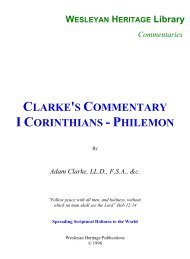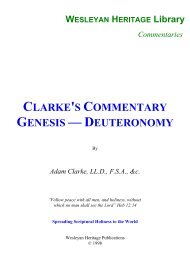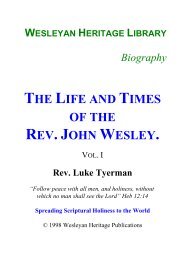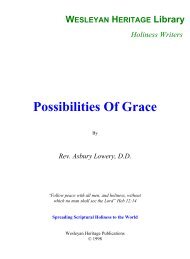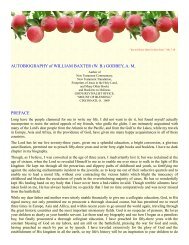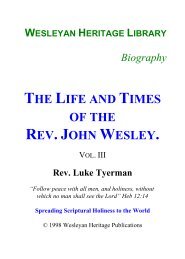2. The Meaning of Sanctification - Enter His Rest
2. The Meaning of Sanctification - Enter His Rest
2. The Meaning of Sanctification - Enter His Rest
Create successful ePaper yourself
Turn your PDF publications into a flip-book with our unique Google optimized e-Paper software.
Stanley Jones is an outstanding example <strong>of</strong> this. Some <strong>of</strong> these men have even preached<br />
against entire sanctification as a theory, but they have had an experience <strong>of</strong> it in their<br />
lives. Pr<strong>of</strong>. William James has gathered many testimonies in his book "Varieties <strong>of</strong><br />
Religious Experience". While some <strong>of</strong> these testimonies are plainly examples <strong>of</strong><br />
abnormal or deranged minds, and they are all laid out by James with the coldness <strong>of</strong> a<br />
scientist examining insect specimens, nevertheless, in many <strong>of</strong> them there is such a<br />
warmth and spiritual reality that even the pr<strong>of</strong>essor himself is compelled to acknowledge<br />
that these people have touched supernatural sources <strong>of</strong> power.<br />
<strong>The</strong> Quakers have preached a form <strong>of</strong> this doctrine for many generations. In 1675 Robert<br />
Barclay wrote fifteen propositions which were universally accepted by the Friends as<br />
expressing their beliefs (although the Friends do not <strong>of</strong>ficially recognize any binding<br />
standards <strong>of</strong> doctrine). <strong>The</strong> Eighth Proposition reads as follows:<br />
"In whom this holy and pure birth is fully brought forth the body <strong>of</strong> death and sin comes<br />
to be crucified and removed, and their hearts united and subjected unto the truth, so as not<br />
to obey any suggestions or temptation <strong>of</strong> the evil one, but to be free from actual sinning<br />
and transgressing <strong>of</strong> the law <strong>of</strong> God, and in that respect perfect. Yet doth this perfection<br />
still admit <strong>of</strong> a growth; and there remaineth a possibility <strong>of</strong> sinning where the mind doth<br />
not most diligently and watchfully attend unto the Lord." [21]<br />
3. THE SYMBOLISM OF THE OLD TESTAMENT<br />
<strong>The</strong> pioneers <strong>of</strong> the holiness movement preached the doctrine <strong>of</strong> entire sanctification with<br />
unflagging zeal. Part <strong>of</strong> the evidences for this truth they drew from the symbolism <strong>of</strong> the<br />
Old Testament.<br />
<strong>The</strong> New Testament writers in general, and the Apostle Paul in particular, did allegorize,<br />
or as we say, “spiritualize,” the historical material <strong>of</strong> the Old Testament; and if we reject<br />
the ideas which they developed in this way, we must deny a large part <strong>of</strong> the New<br />
Testament and reject its teachings.<br />
This is a fact so plain that no scholar would need any evidence to support it, but since we<br />
are not all scholars let us refer to J. A. Weiss. He says that Paul “used this method (I Cor.<br />
9:9; 10:5; Gal. 4:21-31), but not nearly to the same extent as we find it used in the Epistle<br />
to the Hebrews for instance.” [23]<br />
Those parts <strong>of</strong> the Old Testament which are definitely allegorized by New Testament<br />
writers may well be called “types”. This sound critical method opens the door for us into<br />
some very striking truths reflected in the Book <strong>of</strong> Hebrews.<br />
THE REST THAT REMAINETH FOR GOD’S PEOPLE<br />
It would make this book far too long if the writer should do all the work for the reader. To<br />
condense as much as possible, let the student read the fourth chapter <strong>of</strong> the Book <strong>of</strong><br />
Hebrews. This study is worth a day <strong>of</strong> any Christian’s time. <strong>The</strong>re he will learn that the<br />
world was made in six ages <strong>of</strong> time. <strong>The</strong> seventh age began at the close <strong>of</strong> creation and is<br />
continuing to the present moment. It is God’s day <strong>of</strong> rest.<br />
Since it was impossible for the Israelite as a natural man to rest forever in the flesh, one<br />
day in seven was given to him as a type <strong>of</strong> the eternal rest <strong>of</strong> the soul. As God’s rest was<br />
symbolized, or typified, by the Jewish Sabbath, that Jewish Sabbath was a type <strong>of</strong> the rest



